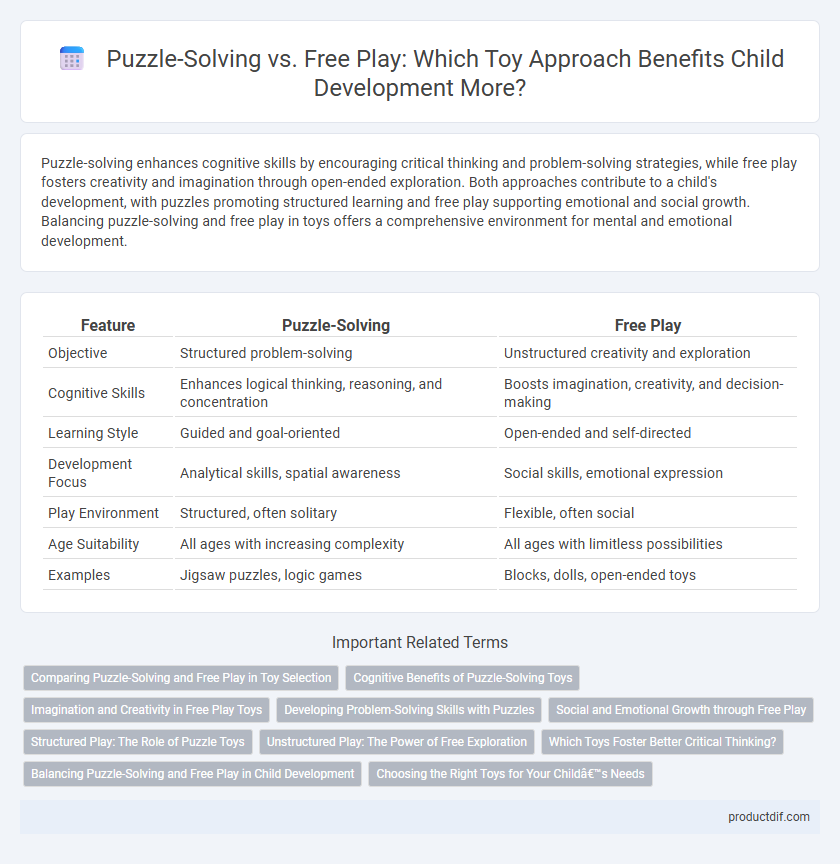Puzzle-solving enhances cognitive skills by encouraging critical thinking and problem-solving strategies, while free play fosters creativity and imagination through open-ended exploration. Both approaches contribute to a child's development, with puzzles promoting structured learning and free play supporting emotional and social growth. Balancing puzzle-solving and free play in toys offers a comprehensive environment for mental and emotional development.
Table of Comparison
| Feature | Puzzle-Solving | Free Play |
|---|---|---|
| Objective | Structured problem-solving | Unstructured creativity and exploration |
| Cognitive Skills | Enhances logical thinking, reasoning, and concentration | Boosts imagination, creativity, and decision-making |
| Learning Style | Guided and goal-oriented | Open-ended and self-directed |
| Development Focus | Analytical skills, spatial awareness | Social skills, emotional expression |
| Play Environment | Structured, often solitary | Flexible, often social |
| Age Suitability | All ages with increasing complexity | All ages with limitless possibilities |
| Examples | Jigsaw puzzles, logic games | Blocks, dolls, open-ended toys |
Comparing Puzzle-Solving and Free Play in Toy Selection
Puzzle-solving toys enhance critical thinking and problem-solving skills by challenging children to find solutions, promoting cognitive development and perseverance. Free play toys encourage creativity, imagination, and social interaction by allowing open-ended exploration without rules or specific goals. Choosing between puzzle-solving and free play toys depends on fostering structured learning versus unstructured creativity to support balanced childhood development.
Cognitive Benefits of Puzzle-Solving Toys
Puzzle-solving toys significantly enhance cognitive development by improving problem-solving skills, spatial reasoning, and memory retention. Engaging with puzzles encourages critical thinking and attention to detail, fostering neural connections essential for advanced learning processes. These toys also promote patience and persistence, key traits that contribute to lifelong intellectual growth.
Imagination and Creativity in Free Play Toys
Free play toys foster imagination and creativity by encouraging children to invent scenarios and explore ideas without predefined goals, unlike puzzle-solving toys that guide problem-solving through specific challenges. Engaging with open-ended toys like building blocks or art supplies stimulates divergent thinking and originality, supporting cognitive growth and emotional expression. This unstructured play environment enhances neural connections related to creative problem-solving and imaginative exploration.
Developing Problem-Solving Skills with Puzzles
Puzzle-solving enhances cognitive abilities by engaging critical thinking and pattern recognition, which are essential for developing problem-solving skills in children. Unlike free play, puzzles provide structured challenges that encourage persistence and logical reasoning while promoting fine motor skills and spatial awareness. Research shows that consistent interaction with puzzles improves memory retention and fosters a growth mindset essential for academic success.
Social and Emotional Growth through Free Play
Free play fosters essential social and emotional growth by encouraging children to express creativity, develop empathy, and improve communication skills without structured rules. Unlike puzzle-solving, which primarily enhances cognitive abilities through problem-solving tasks, free play promotes collaboration and emotional regulation as children navigate social interactions independently. Engaging in imaginative scenarios during free play helps build resilience and self-confidence critical for healthy emotional development.
Structured Play: The Role of Puzzle Toys
Puzzle toys enhance cognitive development by promoting problem-solving skills and logical thinking in children. Structured play with these toys encourages focused attention and perseverance, helping kids build critical thinking abilities through guided challenges. Integrating puzzle toys into playtime balances creativity with mental discipline, fostering both imagination and analytical skills.
Unstructured Play: The Power of Free Exploration
Unstructured play in toys promotes cognitive development by encouraging creativity and problem-solving skills without rigid guidelines. Puzzle-solving enhances logical reasoning and pattern recognition, while free play supports imagination and adaptive thinking through exploration. Combining structured puzzles with unstructured play fosters a balanced approach to learning and skill acquisition in children.
Which Toys Foster Better Critical Thinking?
Puzzle-solving toys, such as jigsaw puzzles, logic games, and brain teasers, significantly enhance critical thinking by promoting problem-solving skills, pattern recognition, and logical reasoning. Free play toys like building blocks and open-ended art supplies encourage creativity and flexible thinking but may not challenge analytical skills as directly. Research shows that combining structured puzzle-solving activities with free play results in the most balanced cognitive development and stronger critical thinking abilities.
Balancing Puzzle-Solving and Free Play in Child Development
Balancing puzzle-solving and free play is crucial for child development, as puzzle activities enhance cognitive skills like problem-solving, spatial reasoning, and memory. Free play encourages creativity, social interaction, and emotional regulation, providing children with opportunities to explore and express themselves independently. Integrating both approaches fosters well-rounded growth by developing analytical thinking alongside imaginative capabilities.
Choosing the Right Toys for Your Child’s Needs
Puzzle-solving toys enhance cognitive development by promoting critical thinking, problem-solving skills, and concentration in children. Free play toys encourage creativity, imagination, and social interaction, fostering emotional growth and adaptability. Selecting toys based on a child's developmental stage and personal interests ensures balanced stimulation and supports holistic learning outcomes.
Puzzle-solving vs free play Infographic

 productdif.com
productdif.com